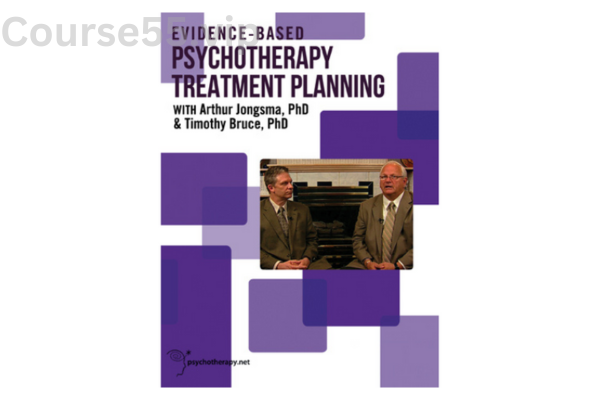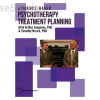Evidence-Based Psychotherapy Treatment Planning with Timothy Bruce & Arthur Jongsma
$49.00 Original price was: $49.00.$7.70Current price is: $7.70.
Evidence-Based Psychotherapy Treatment Planning: A Review of Timothy Bruce and Arthur Jongsma’s Work – Digital Download!

Evidence-Based Psychotherapy Treatment Planning with Timothy Bruce & Arthur Jongsma
Overview

Review of Timothy Bruce and Arthur Jongsma’s Contributions to Evidence-Based Psychotherapy Planning
In today’s climate of heightened accountability in mental health care, the emphasis on evidence-based psychotherapy has never been greater. Drs. Timothy Bruce and Arthur Jongsma’s series on treatment planning based on empirical evidence serves as a cornerstone for practitioners seeking structured, research-driven strategies. Their comprehensive work addresses a broad array of psychological conditions such as anxiety, depression, and substance abuse disorders. Central to their approach is the creation of tailored, research-backed plans aimed at improving therapeutic outcomes — a critical goal shared by therapists and clients alike. By merging foundational theories with hands-on techniques, Bruce and Jongsma offer a pathway for clinicians to achieve meaningful, lasting results.
A Structured Pathway for Evidence-Based Treatment Planning
Implementing a Six-Stage Methodology
Bruce and Jongsma introduce a clear six-stage system designed to refine the psychotherapy planning process. This method helps clinicians approach diverse psychological issues systematically while adhering to best practice standards. The outlined stages include:
-
Assessment: Conducting a detailed evaluation to grasp the client’s unique concerns.
-
Diagnosis: Formulating an accurate identification of the psychological condition.
-
Setting Goals: Defining specific, attainable therapeutic targets.
-
Choosing Interventions: Selecting interventions with strong empirical support that align with the set goals.
-
Applying Interventions: Skillfully implementing the selected methods within therapy sessions.
-
Progress Evaluation: Monitoring client development and modifying the treatment plan as needed.
This structured model acts as a guiding framework, steering clinicians through the intricacies of mental health treatment. Anchored in scientific research, it moves therapists beyond intuition-driven practice toward approaches that are both effective and evidence-supported.
Seamlessly Incorporating Empirically Supported Interventions
A vital element within this six-stage system is the strategic use of empirically supported treatments (ESTs). These interventions, validated through comprehensive research, represent the pinnacle of effective mental health care. Bruce and Jongsma distinguish between interventions categorized as “well-established” and those considered “probably efficacious,” offering clinicians a nuanced perspective on treatment options.
| Category | Definition | Examples |
|---|---|---|
| Well-Established | Treatments backed by robust evidence | Cognitive Behavioral Therapy (CBT), Dialectical Behavior Therapy (DBT) |
| Probably Efficacious | Treatments with moderate support | Acceptance and Commitment Therapy (ACT), Interpersonal Therapy (IPT) |
This classification helps therapists choose interventions confidently, strengthening the therapeutic bond—a critical factor in boosting client commitment and overall therapy success.
Case Illustrations: Translating Theory into Practice
Applying Core Concepts to Real-World Scenarios
A standout feature of Bruce and Jongsma’s work is the use of illustrative case vignettes that show how theoretical principles unfold in practice. These scenarios vividly demonstrate the application of the six-stage model and empirically validated interventions. Take, for instance, a case centered around a client with generalized anxiety disorder (GAD). The therapist, following the structured approach, conducts a detailed assessment leading to a GAD diagnosis, defines treatment goals aimed at symptom reduction and improved coping, selects CBT as the treatment of choice, and continuously evaluates progress to refine the plan.
Strengthening Understanding Through Practical Examples
These case narratives not only make complex ideas more digestible but also offer invaluable teaching moments for clinicians at all experience levels. Watching these principles in action serves as a powerful metaphor—much like a captain relying on a map to navigate turbulent waters, therapists can use structured planning to guide their clients safely through psychological challenges. By sparking reflection and dialogue, these examples inspire professionals to adapt these methods thoughtfully within their own practices.
Historical Foundations and Growth of Evidence-Based Therapy
Charting the Development of Empirically Supported Approaches
An intriguing aspect of Bruce and Jongsma’s series is their exploration of the historical journey behind empirically supported treatments. Understanding this evolution sheds light on how therapy practices have become more ethical, effective, and grounded in scientific inquiry. Early advancements in behavioral therapy, for instance, paved the way for more sophisticated models like CBT—showcasing a transformation comparable to a caterpillar’s metamorphosis into a butterfly, symbolizing ongoing progress and innovation.
Clarifying Treatment Categories
By clearly differentiating between “well-established” and “probably efficacious” interventions, Bruce and Jongsma equip practitioners with the tools needed to make informed, evidence-driven choices. This is particularly important given the overwhelming number of therapeutic options available. Furthermore, they warn against the reliance on mere expert opinion without empirical backing, a pitfall that can lead to ineffective or even harmful practices. Their approach encourages rigorous scrutiny and adherence to scientifically verified methods.
Fostering a Strong Therapeutic Partnership
Building Trust and Cooperation
A central theme in Bruce and Jongsma’s work is the emphasis on building a solid therapeutic alliance—a relationship founded on trust and collaboration between therapist and client. They stress that when clients believe in their therapist’s expertise and sincerity, they are more engaged in their own healing process, which directly correlates with better outcomes. This bond functions much like a sturdy bridge, facilitating safe passage across the often-turbulent journey toward mental wellness.
Methods to Strengthen the Alliance
To reinforce this essential connection, the authors recommend several strategies:
-
Active Listening: Demonstrating sincere interest in the client’s experiences.
-
Empathetic Responses: Acknowledging clients’ feelings without judgment.
-
Transparency: Keeping clients informed about treatment choices and strategies.
-
Consistency: Maintaining regular sessions to build reliability and trust.
Applying these methods helps clinicians foster stronger relationships, setting the stage for deeper therapeutic work and greater client breakthroughs.
Overcoming Practical Challenges in Mental Health Care
Recognizing Barriers
Despite the strength of Bruce and Jongsma’s framework, therapists often encounter practical obstacles in bringing evidence-based methods into daily practice, such as:
-
Limited Resources: Not all practitioners have access to the latest research or continuous learning opportunities.
-
Client Hesitation: Clients may resist evidence-based methods due to misunderstandings or previous negative experiences.
-
Time Constraints: Busy caseloads often leave little room for thorough assessment or ongoing evaluation.
Solutions for Common Issues
Bruce and Jongsma advocate for a flexible, proactive approach to these hurdles, encouraging:
-
Continuous Professional Development: Regularly engaging with new research and training.
-
Strengthening Client Relationships: Building trust to ease client concerns about treatment methods.
-
Adaptive Application: Tailoring evidence-based strategies to fit the client’s unique needs while remaining true to core principles.
By remaining resourceful and committed, therapists can overcome these barriers and uphold the ideals of research-driven care.
Closing Thoughts
In a field that increasingly demands proven results, Bruce and Jongsma’s evidence-based psychotherapy planning series emerges as an indispensable guide for mental health professionals. Through a thoughtful blend of empirical rigor, structured frameworks, and vivid case studies, they offer a valuable resource for enhancing clinical effectiveness. Clinicians who adopt their methods are better equipped to form meaningful therapeutic alliances and deliver individualized, science-based care. Ultimately, Bruce and Jongsma help close the gap between theory and practice, inspiring a future of more informed, compassionate, and effective mental health treatment.
Frequently Asked Questions:
Business Model Innovation: We operate a group buying strategy, allowing participants to share costs and access popular courses at reduced prices. This model benefits individuals with limited financial resources, despite concerns from content creators about distribution methods.
Legal Considerations: The legality of our operations involves complex issues. Although we don’t have explicit permission from course creators to resell their content, there are no specific resale restrictions stated at the time of purchase. This ambiguity creates an opportunity for us to provide affordable educational resources.
Quality Control: We ensure that all course materials purchased are identical to those offered directly by the creators. However, it’s important to understand that we are not official providers. As such, our offerings do not include:
– Live coaching calls or sessions with the course author.
– Access to exclusive author-controlled groups or portals.
– Membership in private forums.
– Direct email support from the author or their team.
We aim to reduce the cost barrier in education by offering these courses independently, without the premium services available through official channels. We appreciate your understanding of our unique approach.
Be the first to review “Evidence-Based Psychotherapy Treatment Planning with Timothy Bruce & Arthur Jongsma” Cancel reply
You must be logged in to post a review.

















Reviews
There are no reviews yet.